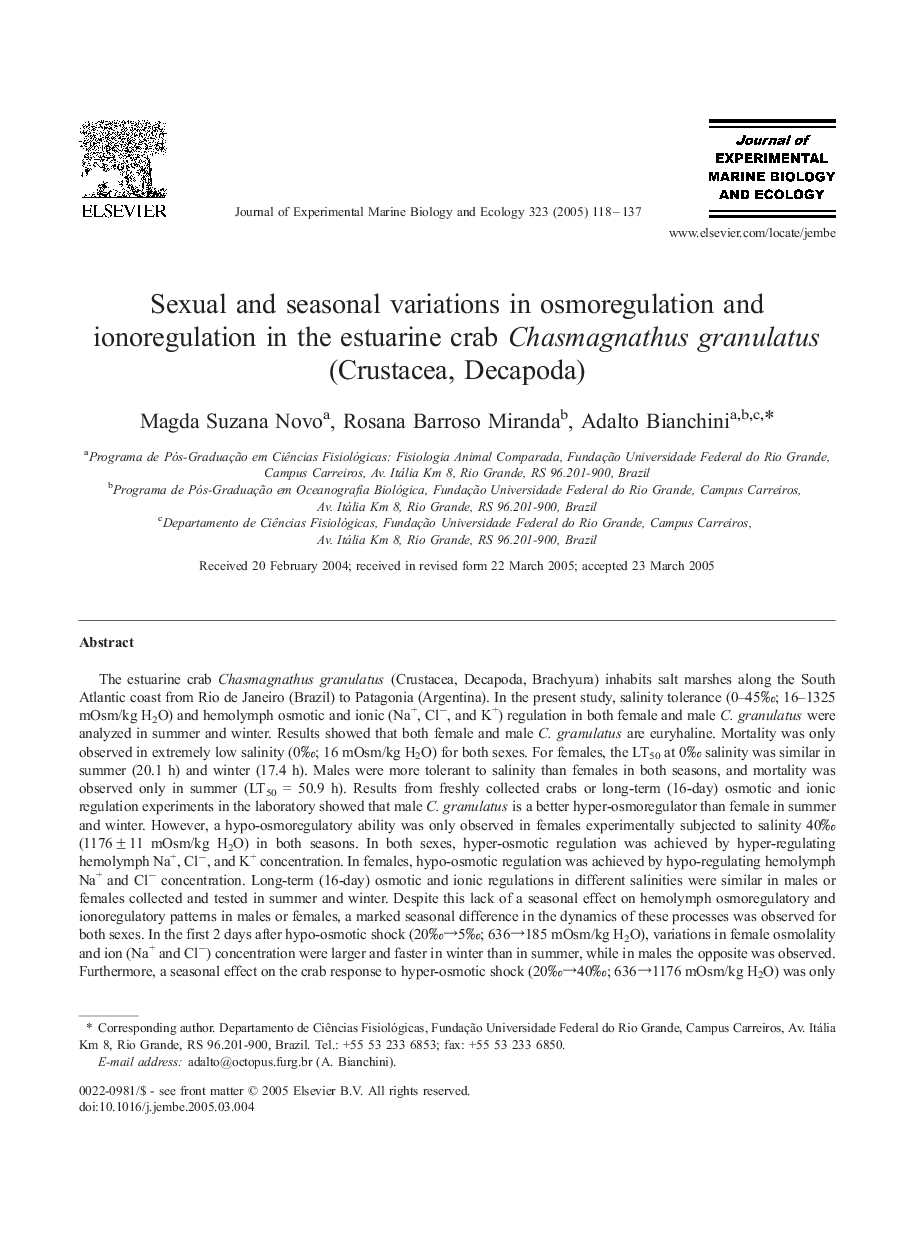| کد مقاله | کد نشریه | سال انتشار | مقاله انگلیسی | نسخه تمام متن |
|---|---|---|---|---|
| 9448714 | 1305947 | 2005 | 20 صفحه PDF | دانلود رایگان |
عنوان انگلیسی مقاله ISI
Sexual and seasonal variations in osmoregulation and ionoregulation in the estuarine crab Chasmagnathus granulatus (Crustacea, Decapoda)
دانلود مقاله + سفارش ترجمه
دانلود مقاله ISI انگلیسی
رایگان برای ایرانیان
کلمات کلیدی
موضوعات مرتبط
علوم زیستی و بیوفناوری
علوم کشاورزی و بیولوژیک
علوم آبزیان
پیش نمایش صفحه اول مقاله

چکیده انگلیسی
The estuarine crab Chasmagnathus granulatus (Crustacea, Decapoda, Brachyura) inhabits salt marshes along the South Atlantic coast from Rio de Janeiro (Brazil) to Patagonia (Argentina). In the present study, salinity tolerance (0-45â°; 16-1325 mOsm/kg H2O) and hemolymph osmotic and ionic (Na+, Clâ, and K+) regulation in both female and male C. granulatus were analyzed in summer and winter. Results showed that both female and male C. granulatus are euryhaline. Mortality was only observed in extremely low salinity (0â°; 16 mOsm/kg H2O) for both sexes. For females, the LT50 at 0â° salinity was similar in summer (20.1 h) and winter (17.4 h). Males were more tolerant to salinity than females in both seasons, and mortality was observed only in summer (LT50 = 50.9 h). Results from freshly collected crabs or long-term (16-day) osmotic and ionic regulation experiments in the laboratory showed that male C. granulatus is a better hyper-osmoregulator than female in summer and winter. However, a hypo-osmoregulatory ability was only observed in females experimentally subjected to salinity 40â° (1176 ± 11 mOsm/kg H2O) in both seasons. In both sexes, hyper-osmotic regulation was achieved by hyper-regulating hemolymph Na+, Clâ, and K+ concentration. In females, hypo-osmotic regulation was achieved by hypo-regulating hemolymph Na+ and Clâ concentration. Long-term (16-day) osmotic and ionic regulations in different salinities were similar in males or females collected and tested in summer and winter. Despite this lack of a seasonal effect on hemolymph osmoregulatory and ionoregulatory patterns in males or females, a marked seasonal difference in the dynamics of these processes was observed for both sexes. In the first 2 days after hypo-osmotic shock (20â°â5â°; 636â185 mOsm/kg H2O), variations in female osmolality and ion (Na+ and Clâ) concentration were larger and faster in winter than in summer, while in males the opposite was observed. Furthermore, a seasonal effect on the crab response to hyper-osmotic shock (20â°â40â°; 636â1176 mOsm/kg H2O) was only observed in males. A new osmolality and ion (Na+ and Clâ) concentration steady state was faster achieved in winter than in summer. Regarding sexual differences, females showed a better capacity to hypo-regulate the hemolymph osmolality and Na+ concentration than males, even after a sudden increase in salinity (hyper-osmotic shock) in both seasons. On the other hand, males showed a better capacity to hyper-regulate the hemolymph osmolality and Na+ concentration than females, even after a sudden decrease in salinity (hypo-osmotic shock), especially in winter. Taken together, results reported in the present study suggest the need to consider both sex and collection season as important factors in future osmotic and ionic regulation studies in estuarine crabs.
ناشر
Database: Elsevier - ScienceDirect (ساینس دایرکت)
Journal: Journal of Experimental Marine Biology and Ecology - Volume 323, Issue 2, 12 October 2005, Pages 118-137
Journal: Journal of Experimental Marine Biology and Ecology - Volume 323, Issue 2, 12 October 2005, Pages 118-137
نویسندگان
Magda Suzana Novo, Rosana Barroso Miranda, Adalto Bianchini,